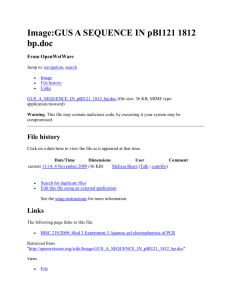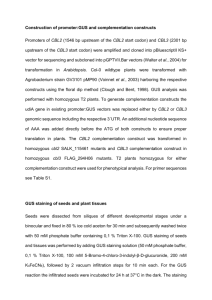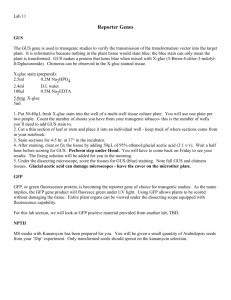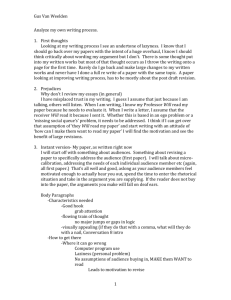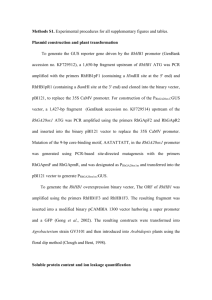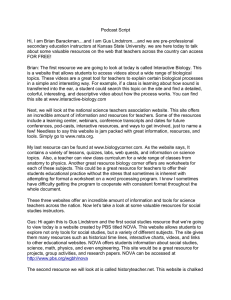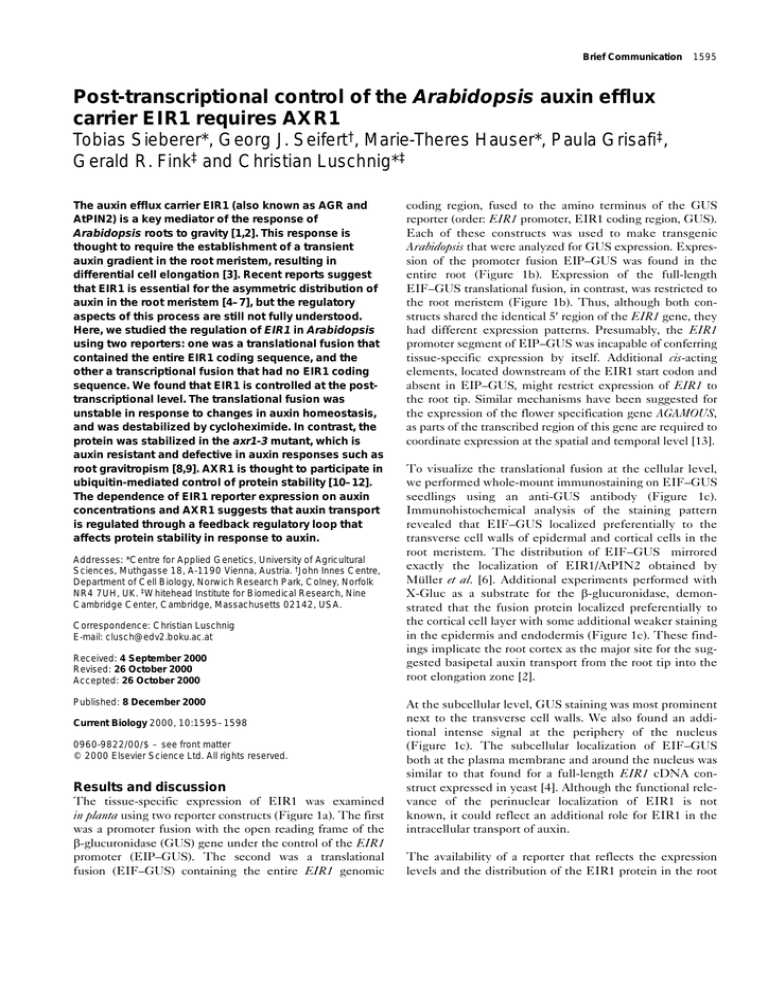
Brief Communication
1595
Post-transcriptional control of the Arabidopsis auxin efflux
carrier EIR1 requires AXR1
Tobias Sieberer*, Georg J. Seifert†, Marie-Theres Hauser*, Paula Grisafi‡,
Gerald R. Fink‡ and Christian Luschnig*‡
The auxin efflux carrier EIR1 (also known as AGR and
AtPIN2) is a key mediator of the response of
Arabidopsis roots to gravity [1,2]. This response is
thought to require the establishment of a transient
auxin gradient in the root meristem, resulting in
differential cell elongation [3]. Recent reports suggest
that EIR1 is essential for the asymmetric distribution of
auxin in the root meristem [4–7], but the regulatory
aspects of this process are still not fully understood.
Here, we studied the regulation of EIR1 in Arabidopsis
using two reporters: one was a translational fusion that
contained the entire EIR1 coding sequence, and the
other a transcriptional fusion that had no EIR1 coding
sequence. We found that EIR1 is controlled at the posttranscriptional level. The translational fusion was
unstable in response to changes in auxin homeostasis,
and was destabilized by cycloheximide. In contrast, the
protein was stabilized in the axr1-3 mutant, which is
auxin resistant and defective in auxin responses such as
root gravitropism [8,9]. AXR1 is thought to participate in
ubiquitin-mediated control of protein stability [10–12].
The dependence of EIR1 reporter expression on auxin
concentrations and AXR1 suggests that auxin transport
is regulated through a feedback regulatory loop that
affects protein stability in response to auxin.
Addresses: *Centre for Applied Genetics, University of Agricultural
Sciences, Muthgasse 18, A-1190 Vienna, Austria. †John Innes Centre,
Department of Cell Biology, Norwich Research Park, Colney, Norfolk
NR4 7UH, UK. ‡Whitehead Institute for Biomedical Research, Nine
Cambridge Center, Cambridge, Massachusetts 02142, USA.
Correspondence: Christian Luschnig
E-mail: clusch@edv2.boku.ac.at
Received: 4 September 2000
Revised: 26 October 2000
Accepted: 26 October 2000
Published: 8 December 2000
Current Biology 2000, 10:1595–1598
0960-9822/00/$ – see front matter
© 2000 Elsevier Science Ltd. All rights reserved.
Results and discussion
The tissue-specific expression of EIR1 was examined
in planta using two reporter constructs (Figure 1a). The first
was a promoter fusion with the open reading frame of the
β-glucuronidase (GUS) gene under the control of the EIR1
promoter (EIP–GUS). The second was a translational
fusion (EIF–GUS) containing the entire EIR1 genomic
coding region, fused to the amino terminus of the GUS
reporter (order: EIR1 promoter, EIR1 coding region, GUS).
Each of these constructs was used to make transgenic
Arabidopsis that were analyzed for GUS expression. Expression of the promoter fusion EIP–GUS was found in the
entire root (Figure 1b). Expression of the full-length
EIF–GUS translational fusion, in contrast, was restricted to
the root meristem (Figure 1b). Thus, although both constructs shared the identical 5′ region of the EIR1 gene, they
had different expression patterns. Presumably, the EIR1
promoter segment of EIP–GUS was incapable of conferring
tissue-specific expression by itself. Additional cis-acting
elements, located downstream of the EIR1 start codon and
absent in EIP–GUS, might restrict expression of EIR1 to
the root tip. Similar mechanisms have been suggested for
the expression of the flower specification gene AGAMOUS,
as parts of the transcribed region of this gene are required to
coordinate expression at the spatial and temporal level [13].
To visualize the translational fusion at the cellular level,
we performed whole-mount immunostaining on EIF–GUS
seedlings using an anti-GUS antibody (Figure 1c).
Immunohistochemical analysis of the staining pattern
revealed that EIF–GUS localized preferentially to the
transverse cell walls of epidermal and cortical cells in the
root meristem. The distribution of EIF–GUS mirrored
exactly the localization of EIR1/AtPIN2 obtained by
Müller et al. [6]. Additional experiments performed with
X-Gluc as a substrate for the β-glucuronidase, demonstrated that the fusion protein localized preferentially to
the cortical cell layer with some additional weaker staining
in the epidermis and endodermis (Figure 1c). These findings implicate the root cortex as the major site for the suggested basipetal auxin transport from the root tip into the
root elongation zone [2].
At the subcellular level, GUS staining was most prominent
next to the transverse cell walls. We also found an additional intense signal at the periphery of the nucleus
(Figure 1c). The subcellular localization of EIF–GUS
both at the plasma membrane and around the nucleus was
similar to that found for a full-length EIR1 cDNA construct expressed in yeast [4]. Although the functional relevance of the perinuclear localization of EIR1 is not
known, it could reflect an additional role for EIR1 in the
intracellular transport of auxin.
The availability of a reporter that reflects the expression
levels and the distribution of the EIR1 protein in the root
1596
Current Biology Vol 10 No 24
Figure 1
(a)
(c)
1 kb
EcoRI ATG uidA
EIP–GUS
aa 647 uidA
U
S
P–
G
U
EI
F–
G
EI
EI
F–
G
U
S
P–
G
U
S
(b)
S
EIF–GUS
EI
Reporter expression in Arabidopsis.
(a) Schematic illustration of the EIP–GUS and
EIF–GUS reporters. EIP–GUS contains the
5′ region of the presumptive EIR1 open
reading frame, which was used previously for
complementation of the eir1-1 mutant [4].
uidA is the gene for GUS. Expression of
EIP–GUS gives rise to a fusion protein
between the first six amino acids of EIR1 and
GUS (grey box). EIF–GUS was made with the
identical 5′ region plus the entire genomic
coding region of the EIR1 gene product. The
GUS gene was introduced after the codon for
amino acid 647 of the presumptive EIR1
protein. (b) Expression of the promoter fusion
EIP–GUS was found in the entire root,
whereas the full-length EIF–GUS translational
fusion was only detectable in root meristems.
(c) Subcellular localization of EIF–GUS at
5 days after germination (DAG). Left, confocal
image of an EIF–GUS root immunostained
with an anti-GUS antibody. The protein was
found in the vicinity of the transverse cell walls
of epidermal and cortical cells. The scale bar
represents 50 µm. No comparable staining
was detected in plants devoid of the reporter
Current Biology
constructs (inset). Right, GUS staining of an
EIF–GUS primary root meristem. Expression
was strongest in the root cortex, with some
additional staining in the epidermis and
endodermis. The scale bar represents 30 µm.
meristem allowed us to test responses of EIR1 to changes
in auxin homeostasis. Treatment of EIF–GUS seedlings
with the potent auxin analogue α-napthaleneacetic acid
(1-NAA) or the inhibitor of polar auxin transport 2,3,5-triiodobenzoic acid (TIBA) for 24 hours caused a pronounced
reduction of the EIF–GUS expression pattern and
reduced β-glucuronidase activities in crude plant extracts
(Figure 2a,c). These results suggest that an alteration in
auxin homeostasis gives rise to a reduced expression of the
auxin efflux carrier. To test whether this response
requires a transcriptional regulation, we compared levels of
the EIR1 transcription as well as the expression of the
EIP–GUS transgene in the presence of either 1-NAA or
TIBA. Unlike the translational fusion, the EIP–GUS
reporter remained highly active when incubated with 1NAA or TIBA (Figure 2a,c). Thus, the 5′ EIR1 promoter
region is not sufficient to confer a response to the
inhibitory effects of an altered auxin homeostasis on EIR1.
To test whether auxin or TIBA treatment have an impact
on transcript levels of EIR1, we performed northern blots
with total root RNA. EIF–GUS plants grown in the presence of TIBA or 1-NAA for 24 hours — a treatment that
causes a reduction in EIF–GUS protein levels — showed
no significant alterations in the levels of EIF–GUS and
EIR1 mRNA (Figure 2b). Thus, EIR1 mRNA levels are
not affected by extensive auxin treatment.
Further evidence for a post-transcriptional regulation of
EIR1 in response to auxin came from equivalent experiments performed with the auxin response mutant axr1-3.
The most prominent signal was observed in
cortical cells next to the transverse cell walls
and in the nuclear periphery (inset; the scale
bar represents 10 µm).
This mutant, thought to be required for the regulation of the
SCFTIR1 complex [10–12], rendered EIF–GUS expression
essentially insensitive to alterations in auxin homeostasis.
Neither TIBA nor 1-NAA treatment led to a significant
reduction of EIF–GUS activity in axr1-3 (Figure 2a,c).
Moreover, as in the wild type, EIR1 mRNA levels in the
axr1-3 mutant remained unaffected by treatment with
TIBA or auxin (Figure 2b).
To test whether the abundance of EIF–GUS is regulated
through the control of protein stability, we performed
quantitative GUS assays with EIF–GUS and EIP–GUS
seedlings grown in the presence of the translational
inhibitor cycloheximide. Cycloheximide treatment had no
significant impact on EIP–GUS expression. Nevertheless,
the same treatment performed with EIF–GUS seedlings
reduced the enzyme activity by 70% after 4 hours incubation (Figure 2c). Thus, the coding region of EIR1 seems
to destabilize the fusion protein, giving rise to an
enhanced protein turnover (Figure 2c). Presumably, the
degradation of EIF–GUS becomes apparent under conditions where the levels cannot be restored by new protein
synthesis. This explanation is also in agreement with previous suggestions that elements involved in auxin efflux
are short-lived [14,15]. In contrast, when comparing wildtype and axr1-3 seedlings expressing EIF–GUS in the
presence of cycloheximide, we found that GUS activities
in axr1-3 plants remained at levels of 80–90% after
2 hours, whereas levels in the wild type dropped to about
50% (Figure 2c). These results suggest that EIF–GUS is
Brief Communication
1597
Figure 2
EIF–GUS
EIR1
UBQ5
axr1-3
axr1-3
EIF–GUS
50
120
Control
CHX
100
100
50
EIR1
80
60
40
20
UBQ5
EI
F–
GU
S
E I axr
F– 1GU 3
EI S
P–
GU
S
0
Current Biology
0
0 2 4
CHX treatment (h)
0
F–
GU
S
a
EI
F– xr1GU 3
S
EIP–GUS
100
EIF–GUS
EIP–GUS
EI
EIF–GUS
150
MS
NAA
TIBA
GUS activity (%)
EIF–GUS
GUS activity (%)
(c)
(b)
GUS activity (%)
1-NAA TIBA
-5
1 -N
AA
TI B
A
MS
GB
(a)
EIR1 expression depends on auxin homeostasis and elements
involved in auxin signal transduction. (a) GUS staining in EIF–GUS
and EIP–GUS seedlings at 5 DAG. Both TIBA and 1-NAA led to a
significant reduction of EIF–GUS staining in the root meristem of
ColO wild-type seedlings. EIP–GUS staining was not affected by
1-NAA or TIBA. EIF–GUS staining remained visible in the presence of
1-NAA or TIBA when expressed in axr1-3 mutants. MS, Murashige
and Skoog medium. (b) Northern blots of total root RNA from
EIF–GUS and axr1-3 seedlings. The transcript levels of EIR1 and
EIF–GUS were essentially unaffected by treatment with either 1-NAA
or TIBA. UBQ5 represents the loading control. GB-5, Gamborg’s B-5
Medium. (c) Fluorometric quantitation of GUS activity. Relative activity
is shown normalized to the protein content in plant extracts. Activities
are plotted as percent of activity found in the untreated controls.
Standard deviations of parallel samples are indicated as bars. Left,
EIF–GUS activity in the wild type responded to alterations in auxin
homeostasis by a decrease of about 65–75%. In axr1-3 mutants,
EIF–GUS showed a significantly reduced response to 1-NAA
treatment. No significant alterations were seen in the presence of
TIBA. EIP–GUS activity remained essentially unaltered in the
presence of either 1-NAA or TIBA. Middle, cycloheximide (CHX)
treatment of EIF–GUS and EIP–GUS seedlings performed in liquid
medium. After 4 h, EIF–GUS activities were reduced to about 30%.
Right, EIF–GUS was stabilized in axr1-3 mutants. After 2 h incubation
in the presence of cycloheximide, EIF–GUS activity in axr1-3 mutants
remained at levels between 80% and 90%. EIF–GUS activity in the
wild type was reduced to approximately 50% when compared with
untreated controls.
stabilized to the effects of cycloheximide in the putative
proteolysis mutant axr1-3.
no additional, stably inherited phenotypes were observed
in these transgenic lines. Thus, the expression of the
EIR1 cDNA, whose transcript was detectable in the entire
transgenic seedlings, did not cause any phenotypic alterations that are unrelated to the rescue of eir1-1 defects.
Although we cannot exclude the possibility that other
mechanisms regulate the stability of the ectopically
expressed EIR1 cDNA, our findings provide further
support for the suggestion that EIR1 expression is controlled at the level of protein stability.
Our results suggest that protein stability in response to
alterations in auxin homeostasis is critical for EIF–GUS
reporter expression. Thus, EIR1 activity might be regulated at a post-transcriptional level as well. To test
whether the function of the EIR1 protein in auxin transport can be completely uncoupled from transcriptional
control, we analyzed transgenic plants expressing the
EIR1 cDNA under the control of the heterologous cauliflower mosaic virus (CaMV) 35S promoter. Expression of
this construct completely suppressed the defect caused by
the eir1-1 mutation (Figure 3). The response of transgenic
plants to gravity and to 1 µM 1-aminocyclopropane-1-carboxylic acid (ACC; the precursor to ethylene) was similar
to the wild type (Figure 3b,c). The reduction of longitudinal cell elongation and the induction of root hairs by ethylene in the transgenic plants was similar to that manifested
by wild-type plants (Figure 3b). Those transgenic lines
with no detectable expression of the EIR1 gene product
still exhibited the eir1 mutant phenotypes, suggesting that
the rescue of eir1-1 defects correlates with the ectopic
expression of the EIR1 cDNA (Figure 3). Nevertheless,
Assuming that EIR1 is required for basipetal transport of
auxin from the root tip into the elongation zone, control of
EIR1 by protein degradation would permit a rapid
response to gravistimulation. This mechanism would also
be consistent with the postulated establishment of transient auxin gradients required for root bending. Proteolytic degradation of EIR1 via activation of AXR1 could
be essential for the establishment of an auxin gradient
either during the initial response to gravity or, alternatively, in rapidly switching back to default levels once the
root has reoriented. In either scenario, if AXR1 responds
to auxin levels, then there is a mechanism for feedback
inhibition of auxin transport into the root elongation zone.
1598
Current Biology Vol 10 No 24
References
-1 /
eir1-1/BcEI2-2
eir1
eir1
-1 /
- 1/ B
eir1
eir1
- 1/ B
(b)
cE I
2BcE 2
I8-1
Co
lO
(a)
cE I
2BcE 2
I8-1
Co
lO
Figure 3
eir1-1/BcEI8-1
EIR1
18S
ColO
(c)
eir1-1/BcEI2-2
eir1-1/BcEI8-1
ColO
Current Biology
Ectopic EIR1 expression rescues eir1-1 defects. (a) Northern blot of
total RNA from transgenic ColO plants transformed with pBcEI,
which expresses the EIR1 cDNA under control of a CaMV 35S
promoter. Total RNA was hybridized with an EIR1 probe, and the
level of 18S rRNA confirmed equal loading. Note the lack of a
hybridizing band in the ColO RNA lane, indicating the high level of
constitutive EIR1 overexpression in the transgenic line eir1-1
BcEI8-1. No expression was seen in line eir1-1 BcEI2-2.
(b) Response of transgenic plants towards ethylene. Left,
comparison of ColO, eir1-1 BcEI8-1 and eir1-1 BcEI2-2 seedlings
germinated on 1 µM ACC. The eir1-1 BcEI8-1 line, which showed
strong expression of the transgene, exhibited ethylene responses
similar to the wild type. Root growth of eir1-1 BcEI2-2 remained
resistant to ACC. Right, parts of the primary root differentiation zone
viewed under differential interference contrast (40 ×). ColO roots on
1 µM ACC formed short, expanded root cells and an increased
number of root hairs. The eir1-1 BcEI8-1 plants, which expressed
EIR1 cDNA, responded to ACC in a similar way to ColO wild-type
plants whereas eir1-1 BcEI2-2 plants did not respond to the growth
regulator. (c) Ectopic expression of EIR1 rescues the gravitropic
defects of the eir1-1 mutant. In the line eir1-1 BcEI8-1 as in the wild
type, root growth was reoriented when the plant was grown on
vertically oriented plates. The line eir1-1 BcE2-2, which had no
detectable EIR1 transcript, did not respond to gravity.
As a consequence, the degradation of EIR1 would provide
a rapid method for equilibrating the flow of auxin within
the root meristem.
Supplementary material
Supplementary material including additional methodological detail is
available at http://current-biology.com/supmat/supmatin.htm.
Acknowledgements
The axr1-3 seeds were obtained from the Arabidopsis Stock Center. C.L.
thanks Jian Hua, Steffen Rupp, Lukas Mach, Josef Glössl and Martin Polz
for help and discussion. This work was supported by FWF grants P13353GEN, P13948-GEN and by APART from the Austrian Academy of Sciences. G.R.F. is an American Cancer Society Professor of Genetics.
1. Roman G, Lubarsky B, Kieber JJ, Rotheneberg M, Ecker JR: Genetic
analysis of ethylene signal transduction in Arabidopsis thaliana:
five novel mutant loci integrated into a stress response pathway.
Genetics 1995, 139:1393-1409.
2. Rashotte AM, Brady SR, Reed RC, Ante SJ, Muday GK: Basipetal
auxin transport is required for gravitropism in roots of
Arabidopsis. Plant Physiol 2000, 122:481-490.
3. Kaufman PB, Wu L-L, Brock TG, Kim D: Hormones and the
orientation of growth. In Plant Hormones. Edited by Davies PJ.
Dordrecht: Kluwer Academic Publishers; 1995:547-571.
4. Luschnig C, Gaxiola RA, Grisafi P, Fink GR: EIR1, a root-specific
protein involved in auxin transport, is required for gravitropism in
Arabidopsis thaliana. Genes Dev 1998, 12:2175-2187.
5. Utsuno K, Shikanai T, Yamada Y, Hashimoto T: Agr, an Agravitropic
locus of Arabidopsis thaliana, encodes a novel membrane-protein
family member. Plant Cell Physiol 1998, 39:1111-1118.
6. Müller A, Guan C, Gälweiler L, Tänzler P, Huijser P, Marchant A, et al.:
AtPIN2 defines a locus of Arabidopsis for root gravitropism
control. EMBO J 1998, 17:6903-6911.
7. Chen R, Hilson P, Sedbrook J, Rosen E, Caspar T, Masson PH:
The Arabidopsis thaliana AGRAVITROPIC 1 gene encodes a
component of the polar-auxin-transport efflux carrier. Proc Natl
Acad Sci USA 1998, 95:15112-15117.
8. Lincoln C, Britton JH, Estelle M: Growth and development of the
axr1 mutants of Arabidopsis. Plant Cell 1990, 2:1071-1080.
9. Leyser HM, Lincoln CA, Timpte C, Lammer D, Turner J, Estelle M:
Arabidopsis auxin-resistance gene AXR1 encodes a protein
related to ubiquitin-activating enzyme E1. Nature 1993,
364:161-164.
10. Pozo JC, Timpte C, Tan S, Callis J, Estelle M: The ubiquitin-related
protein RUB1 and auxin response in Arabidopsis. Science 1998,
280:1760-1763.
11. del Pozo JC, Estelle M: The Arabidopsis cullin AtCUL1 is modified
by the ubiquitin-related protein RUB1. Proc Natl Acad Sci USA
1999, 96:15342-15347.
12. Gray WM, del Pozo JC, Walker L, Hobbie L, Risseeuw E, Banks T,
et al.: Identification of an SCF ubiquitin-ligase complex required
for auxin response in Arabidopsis thaliana. Genes Dev 1999,
13:1678-1691.
13. Sieburth LE, Meyerowitz EM: Molecular dissection of the
AGAMOUS control region shows that cis elements for spatial
regulation are located intragenically. Plant Cell 1997, 9:355-365.
14. Morris DA, Rubery PH, Jarman J, Sabater M: Effects of inhibitors of
protein synthesis on transmembrane auxin transport in Cucurbita
pepo L. hypocotyl segments. J Exp Botany 1991, 42:773-783.
15. Delbarre A, Muller P, Guern J: Short-lived and phosphorylated
proteins contribute to carrier-mediated efflux, but not to influx, of
auxin in suspension-cultured tobacco cells. Plant Physiol 1998,
116:833-844.


